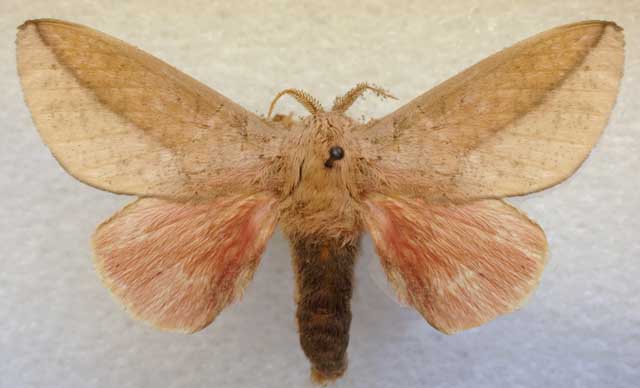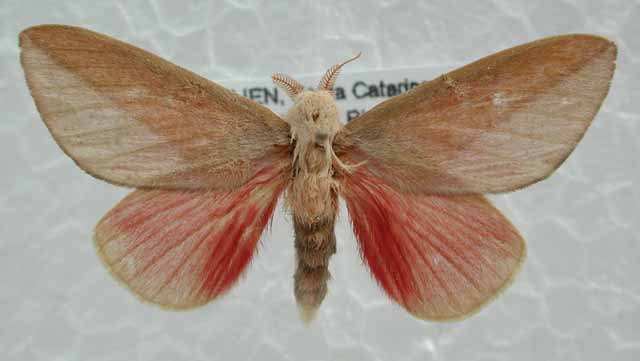Scolesa totoma
|
|
Updated as per Lemaire's Ceratocampinae 1988, October 3, 2006
Updated as per Rio Grande do Sul: Arsenurinae and Ceratocampinae; April 26, 2013
Updated as per personal communication with Ryan Saint Laurent (Smithsonian Type image); January 17, 2014
|
Scolesa totoma
skoh-LEE-suhMtoh-TOH-mah
(Schaus, 1900) Adelocephala

Scolesa totama male HT,
The Smithsonian Insect Collection (USNM) courtesy of Ryan Saint Laurent
This site has been created by
Bill Oehlke at oehlkew@islandtelecom.com
Comments, suggestions and/or additional information are welcomed by Bill.
TAXONOMY:
Superfamily: Bombycoidea, Latreille, 1802
Family: Saturniidae, Boisduval, [1837] 1834
Subfamily: Ceratocampinae, Harris, 1841
was Adelowalkeriinae: Travassos & Noronha, 1967
Genus: Scolesa, Michener, 1949
Species: totoma, Schaus, 1900
|
MIDI MUSIC
"WhatAWonderfulWorld"
copyright C. Odenkirk
MIDI CITY
ON.OFF
<bgsound src="world.mid" LOOP=FOREVER>
|
DISTRIBUTION:
Scolesa totoma (wingspan: males: 44-54mm; females: 56-70mm // forewing length: males: 23.4-24.2mm; females: 30.0-31.0mm) flies in
southeastern Brazil: Rio de Janeiro, Sao Paulo,
Parana, Santa Catarina and Rio Grande do Sul.
In both sexes, the dorsal surface of the abdomen is black.

Scolesa species ??, Santa Catarina, Brazil, or Alto Paraguay, Paraguay,
Cornell University Collection, courtesy of Ryan Saint Laurent.
The image directly above, sent to me by Ryan Saint Laurent from the Cornell University Collection, has had the entire right side digitally copied to
the left side by me (Bill Oehlke), without further reconstruction. The label in the CUC collection indicated S. Cath., Brazil, and Alto Paraguay, so the original source location of the specimen is
unclear. The pml does not match the almost entirely perfectly straight pml in Scolesa totoma specimens, so I do not think it is that species, nor is it a
particularly good match fro Scolesa jauffreti. I am not even 100% sure it is a Scolesa species.

Scolesa totoma?? (male), Santa Catarina, Brasil, courtesy of
Eric van Schayck.
The image directly above shows a forewing pm line that is less preapical than the specimens from the Smithsonian and cornell University collections.
It also seems to have less spotted, and therefore it could be something other than totoma. (Bill Oehlke)
FLIGHT TIMES AND PREFERRED FOOD PLANTS:
There are probably three broods annually in February-March and then again in July-August and in November.
In Rio Grande do Sul, Brazil, moths are on the wing in January-March, May-June, August-November, suggesting 3-4 annual broods.
Larval hosts are unknown.

Scolesa totoma female
ECLOSION, SCENTING AND MATING:
Scolesa totoma moths emerge from subterrranean pupae. Females call from 10:30 pm until 12:30 am and then make their
ovipositing flights over the next several nights.

Scolesa totoma female, Claude Lemaire
EGGS, LARVAE AND PUPAE:
Eggs are translucent and development can be seen through eggshells.
Newly emerged larvae are particularly well adorned with thoracic "horns".
Mature larvae leave the foodplant to pupate in
subterranean chambers.
Larval Food Plants
It is hoped that this alphabetical listing followed by the common
name of the foodplant will prove useful. The list is not exhaustive.
Experimenting with closely related foodplants is worthwhile.
Use your browser "Back" button to return to the previous page.
Return to Scolesa Index
Goto South American Saturniidae Directory
Goto Main Index
The pronunciation of scientific names is
troublesome for many. The "suggestion" at the top of the page is
merely a suggestion. It is based on commonly
accepted English pronunciation of Greek names and/or some
fairly well accepted "rules" for latinized scientific names.
The suggested pronunciations, on this page and on other pages,
are primarily put forward to assist those who hear with internal
ears as they read.
There are many collectors from different countries whose
intonations and accents would be different.
I do not know the meaning of or reason for the genus name "Scolesa".
The species name "totoma" is a mystery to me.




